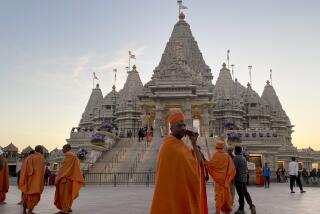Followers of Early Mideast Religion Build a Temple in the U.S.
- Share via
VIENNA, Va. — One of the world’s oldest religions is establishing a new American temple outside the nation’s capital, the Zoroastrian Center and Darb-e-Mehr.
“You will see a magnificent building that reminds you of old Persian architecture,” said Farhad Shahryary, assistant secretary of the temple committee. “This is a really joyful day. There’s been a lot of hard work. This has been a dream for about 20 years.”
Once the state religion of an empire that stretched throughout much of the ancient world, Zoroastrianism has about 200,000 adherents worldwide, although some estimates say the number is fewer.
Up to 15,000 believers are in the United States, with the largest concentration in Southern California’s large Iranian immigrant population.
The Darb-e-Mehr, or fire temple, will be home to members of the 24-year-old Zoroastrian Assn. of Metropolitan Washington, said Jamshid Goshtasbi, the group’s president.
Ground was broken on the fire temple last week -- fire having importance in the faith as a symbol of eternal truth and law.
“It was decided to have something really big, being in the capital of the United States, which is basically the capital of the world,” Goshtasbi said. “This will be a national center, a world center.”
Zoroastrianism is considered among the oldest monotheistic religions and is named for its prophet Zarathushtra -- in Greek, Zoroaster.
Tradition holds that the faith was founded about 8000 BC, although there is wide disagreement among scholars about the faith’s true historical origins. Many say it perhaps emerged about 1200 BC or even centuries later.
The faith reached its zenith as the state religion of the Persian empire, in present-day Iran, until the 7th century AD, when it was supplanted by Islam.
While Zoroastrianism is tolerated in the Koran, adherents were periodically persecuted and Zoroastrian groups migrated into India and Pakistan in the 10th century, where they are known today as Parsis.
Like Goshtasbi, a professor of electrical engineering at Howard University, most of the Zoroastrians in the United States are here because of upheaval elsewhere in the world.
“I am from Iran, originally,” Goshtasbi said. “I came here right before the Islamic Revolution in 1978. I came here to finish my education and go back in four years, and now it’s more than 20 years.”
In Iran under its pre-revolutionary ruler, Shah Reza Pahlavi, nationalism encouraged citizens to take pride in Zoroastrianism as the country’s historical religion.
Zoroastrians were able to attain positions of considerable prestige in society and government.
Among them was Farhang Mehr, a professor at Boston University, who was deputy prime minister of Iran under the shah. “I hope this center will be a place where we invite members of other religions. Don’t be afraid, let them come and learn,” Mehr said.
With their relatively small numbers, two hot topics in the denomination are traditional Zoroastrians’ condemnation of marriage outside the faith and their refusal to recognize converts.
Still, Zoroastrian numbers are growing in the United States and other Western countries, so it appears less likely today than just a few decades ago that the long-established faith will become extinct.
More to Read
Sign up for Essential California
The most important California stories and recommendations in your inbox every morning.
You may occasionally receive promotional content from the Los Angeles Times.











